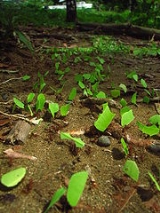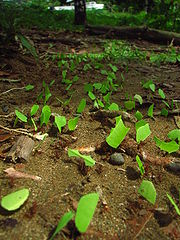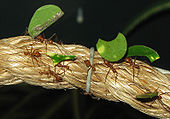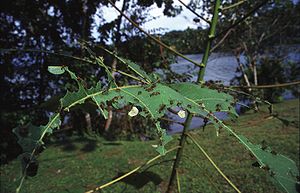
Leafcutter ant
Encyclopedia

Species
In biology, a species is one of the basic units of biological classification and a taxonomic rank. A species is often defined as a group of organisms capable of interbreeding and producing fertile offspring. While in many cases this definition is adequate, more precise or differing measures are...
of leaf-chewing ant
Ant
Ants are social insects of the family Formicidae and, along with the related wasps and bees, belong to the order Hymenoptera. Ants evolved from wasp-like ancestors in the mid-Cretaceous period between 110 and 130 million years ago and diversified after the rise of flowering plants. More than...
s belonging to the two genera
Genus
In biology, a genus is a low-level taxonomic rank used in the biological classification of living and fossil organisms, which is an example of definition by genus and differentia...
Atta and Acromyrmex
Acromyrmex
Acromyrmex is a genus of New World ants of the subfamily Myrmicinae. It contains 31 known species.-Distribution:This genera is found in South America and parts of Central America and the Caribbean islands.-Overview:...
.
These species of tropical, fungus-growing ants
Fungus-growing ants
The fungus-growing ants comprises all the known fungus-growing ant species in the world participating in ant-fungus mutualism. Leafcutter ants, including Atta and Acromyrmex, make up 2 of the genera.-See also:...
are all endemic to South
South America
South America is a continent situated in the Western Hemisphere, mostly in the Southern Hemisphere, with a relatively small portion in the Northern Hemisphere. The continent is also considered a subcontinent of the Americas. It is bordered on the west by the Pacific Ocean and on the north and east...
, Central America
Central America
Central America is the central geographic region of the Americas. It is the southernmost, isthmian portion of the North American continent, which connects with South America on the southeast. When considered part of the unified continental model, it is considered a subcontinent...
, Mexico
Mexico
The United Mexican States , commonly known as Mexico , is a federal constitutional republic in North America. It is bordered on the north by the United States; on the south and west by the Pacific Ocean; on the southeast by Guatemala, Belize, and the Caribbean Sea; and on the east by the Gulf of...
and parts of the southern United States
United States
The United States of America is a federal constitutional republic comprising fifty states and a federal district...
.
The Acromyrmex and Atta ants have much in common anatomically; however, the two can be identified by their external differences. Atta ants have three pairs of spines and a smooth exoskeleton
Exoskeleton
An exoskeleton is the external skeleton that supports and protects an animal's body, in contrast to the internal skeleton of, for example, a human. In popular usage, some of the larger kinds of exoskeletons are known as "shells". Examples of exoskeleton animals include insects such as grasshoppers...
on the upper surface of the thorax
Thorax (insect anatomy)
The thorax is the mid section of the insect body. It holds the head, legs, wings and abdomen. It is also called mesosoma in other arthropods....
, while Acromyrmex ants have four pairs and a rough exoskeleton.
Next to humans, leafcutter ants form the largest and most complex animal societies on Earth. In a few years, the central mound of their underground nests can grow to more than 30 metres (98.4 ft) across, with smaller, radiating mounds extending out to a radius of 80 metres (262.5 ft), taking up 30 to 600 m² (322.9 to 6,458.3 sqft) and containing eight million individuals.
Reproduction and colony founding

Ant colony
An ant colony is an underground lair where ants live, eat and mate. Colonies consist of a series of underground chambers, connected to each other and the surface of the earth by small tunnels. There are rooms for nurseries, food storage, and mating...
.
Once on the ground, the female loses her wings and searches for a suitable underground lair in which to found her colony. The success rate of these young queens is very low, and only 2.5% will go on to establish a long-lived colony. To start her own fungus garden, the queen stores bits of the parental fungus garden mycelium
Mycelium
thumb|right|Fungal myceliaMycelium is the vegetative part of a fungus, consisting of a mass of branching, thread-like hyphae. The mass of hyphae is sometimes called shiro, especially within the fairy ring fungi. Fungal colonies composed of mycelia are found in soil and on or within many other...
in her infrabuccal pocket, which is located within her oral cavity.
Colony hierarchy
In a mature leafcutter colony, ants are divided into castesEusociality
Eusociality is a term used for the highest level of social organization in a hierarchical classification....
, based mostly on size, that perform different functions. Acromyrmex and Atta exhibit a high degree of biological polymorphism
Polymorphism (biology)
Polymorphism in biology occurs when two or more clearly different phenotypes exist in the same population of a species — in other words, the occurrence of more than one form or morph...
, four castes being present in established colonies - minims, minors, mediae and majors. Majors are also known as soldiers or dinergates. Atta ants are more polymorphic than Acromyrmex, meaning there is comparatively less difference in size from the smallest to largest types of Acromymex.

- Minims are the smallest workers, and tend to the growing brood or care for the fungus gardens. Head width is less than 1 mm.
- Minors are slightly larger than minima workers, and are present in large numbers in and around foraging columns. These ants are the first line of defense and continuously patrol the surrounding terrain and vigorously attack any enemies that threaten the foraging lines. Head width is around 1.8-2.2 mm.
- Mediae are the generalized foragers, which cut leaves and bring the leaf fragments back to the nest.
- Majors, the largest worker ants, act as soldiers, defending the nest from intruders, although there is recent evidence that majors participate in other activities, such as clearing the main foraging trails of large debris and carrying bulky items back to the nest. The largest soldiers (Atta laevigataAtta laevigataAtta laevigata is one of about a dozen species of leafcutter ants in the genus Atta, found from Colombia south to Paraguay. This species is one of the largest leafcutter species, and can be recognized by the smooth and shining head of the largest workers in a colony...
) may have total body lengths up to 16 mm and head widths of 7 mm.
Ant-fungus mutualism
Their societies are based on an ant-fungus mutualismAnt-fungus mutualism
Ant-fungus mutualism is a symbiosis seen in certain ant and fungal species, where ants actively cultivate fungus much like humans farm crops as a food source. In some species, the ants and fungi are dependent on each other for survival. The leafcutter ant is a well known example of this symbiosis...
, and different species of ants use different species of fungus, but all of the fungi the ants use are members of the Lepiotaceae family. The ants actively cultivate their fungus, feeding it with freshly cut plant material and keeping it free from pests and mold
Mold
Molds are fungi that grow in the form of multicellular filaments called hyphae. Molds are not considered to be microbes but microscopic fungi that grow as single cells called yeasts...
s. This mutualistic relationship is further augmented by another symbiotic
Symbiosis
Symbiosis is close and often long-term interaction between different biological species. In 1877 Bennett used the word symbiosis to describe the mutualistic relationship in lichens...
partner; a bacterium that grows on the ants and secretes chemicals, - essentially the ants use portable antimicrobial
Antimicrobial
An anti-microbial is a substance that kills or inhibits the growth of microorganisms such as bacteria, fungi, or protozoans. Antimicrobial drugs either kill microbes or prevent the growth of microbes...
s. Leaf cutter ants are sensitive enough to adapt to the fungi's reaction to different plant material, apparently detecting chemical signals from the fungus. If a particular type of leaf is toxic to the fungus, the colony will no longer collect it. The only two other groups of insects that utilize fungus-based agriculture are ambrosia beetles and termites. The fungus cultivated by the adults is used to feed the ant larvae, and the adult ants feed off the leaf sap. The fungus needs the ants to stay alive, and the larvae need the fungus to stay alive.
Waste management



Cultivar
A cultivar'Cultivar has two meanings as explained under Formal definition. When used in reference to a taxon, the word does not apply to an individual plant but to all those plants sharing the unique characteristics that define the cultivar. is a plant or group of plants selected for desirable...
threatens the ants' food source, and is thus a constant danger to the ants. The waste-transporters and waste heap workers are the older, more dispensable leaf-cutter ants, ensuring the healthier and younger leaf-cutter ants can work on the fungal garden. The Atta colombica
Atta colombica
Atta colombica is one of 41 species of leafcutter ant. This species is part of the Attini tribe .-Description:Workers of this species are maroon in colour, and are entirely matte, with no shiny spots.-Distribution:...
species, unusually for the Attine tribe, have an external waste heap. Waste-transporters take the waste, which consists of used substrate and discarded fungus, to the waste heap. Once dropped off at the refuse dump, heap-workers organise the waste and constantly shuffle it around to aid decomposition. A compelling observation of Atta colombica was that the dead ants were placed around the perimeter of the waste heap.
In addition to feeding the fungal garden with foraged food, mainly consisting of leaves, it is protected from Escovopsis by the antibiotic secretions of Actinobacteria
Actinobacteria
Actinobacteria are a group of Gram-positive bacteria with high guanine and cytosine content. They can be terrestrial or aquatic. Actinobacteria is one of the dominant phyla of the bacteria....
(genus Pseudonocardia
Pseudonocardia
Pseudonocardia is the type genus of the bacteria family Pseudonocardiaceae. Members of this genus have been found living mutualistically in the metapleural glands of the leafcutter ants.-Species:...
). This mutualistic micro-organism lives in the metapleural glands of the ant. Actinobacteria are responsible for producing the majority of the world's antibiotics today.
Parasitism

Phorid fly
Phoridae is a family of small, hump-backed flies resembling fruit flies. Phorid flies can often be identified by their escape habit of running rapidly across a surface rather than taking to the wing. This behaviour is a source of one of their alternate names: scuttle fly. They are a diverse and...
, a parasitic pest which lays eggs into the crevices of the worker ants' head. Often a minim will sit on the worker ant and ward off any attack.
Also, the wrong type of fungus can grow during cultivation. Escovopsis is a highly virulent fungus that has the potential to devastate an ant garden; as it is horizontally transmitted. It Currie et al. (1999) found that Escovopsis was cultured, during colony foundation, in 6.6% of colonies. However, in one to two year old colonies, almost 60% had Escovopsis growing in the fungal garden.
Interactions with humans
In some parts of their range, leafcutter ants can be quite a nuisance to humans, defoliating crops and damaging roads and farmland with their nest-making activities. For example, some Atta species are capable of defoliating an entire citrus tree in less than 24 hours.Deterring the leafcutter ant Acromyrmex lobicornis
Acromyrmex lobicornis
Acromyrmex lobicornis is a species of leaf-cutter ant, a New World ant of the subfamily Myrmicinae of the genus Acromyrmex. This species is from one of the two genera of advanced attines within the tribe Attini.-Subspecies:...
from defoliating crops has been found simpler than first expected. Collecting the refuse from the nest and placing it over seedlings or around crops resulted in a deterrent effect over a period of 30 days.

